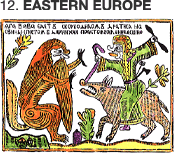
THE BABA IAGA
The baba iaga, mounted on a pig, confronts a crocodile in this early 18th century woodcut. she waves a pestle, normally her means of propelling herself when she travels inside her mortar. By far the best known mythical fiogure in slav folk tales is the witch, the baba iaga.
She has power over birds and beasts and travels in a mortar, propelling herself along with a pestle and erasing her tracks with a broom. more often she is encountered in her hut, which stands on chicken legs in the midst of a dense forest. To enter, the hero or heroine must utter a magic formula, upon which the hut will turn to reveal the door. the baba iaga fills the interior, a hidious aged crone whose long nose presses the ceiling, while her legs straddle the entire room. she is so scrawny that she resembles a skeleton with sharp teeth. she is known as "bonyleg" and her garden fence is made of bones. The houses remote location implies guardianship of the gateway to the other world; certainly, entry into her hut may mean death.
There is a clear link withpre-historic initiation rites: initiation into manhood in many cultures is enacted in a special building outside the village, and initiates are believed to die before being reborn. Day and night obey the baba iaga' s commands, suggesting that her origins may lie in a once powerful godess of the other world. This theory is supported by the occasionally positive roleshe plays in helping the hero in his quest, a relic of a time before her cult was overthrown.